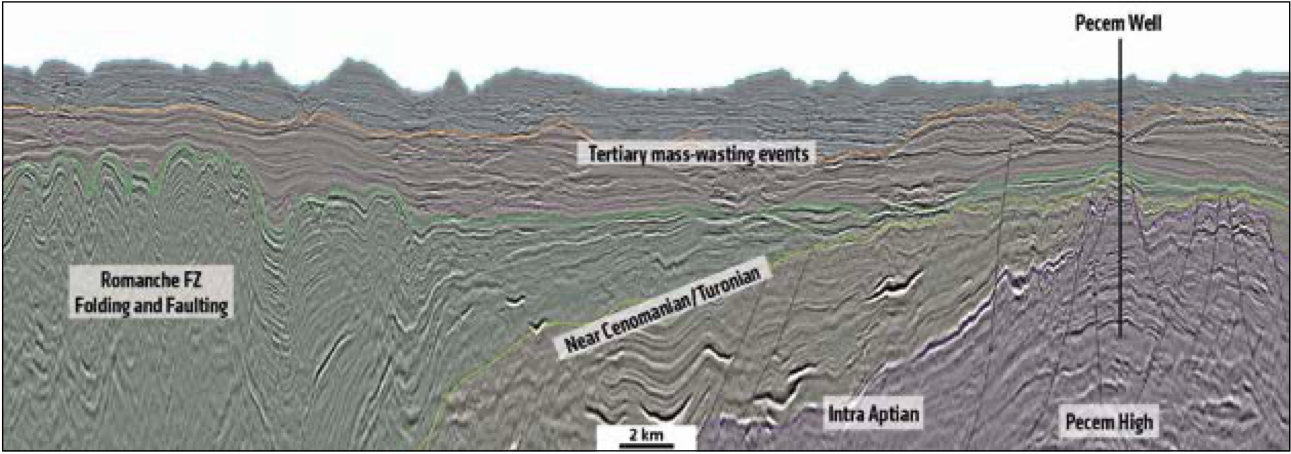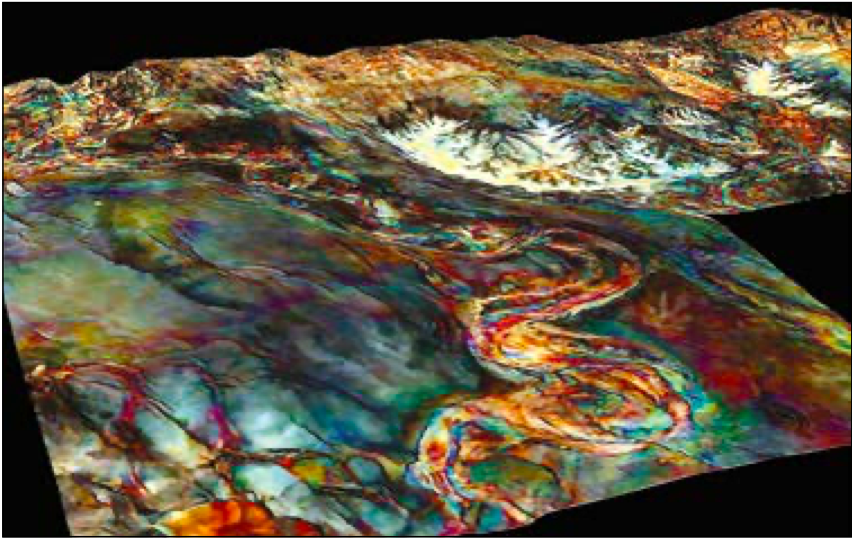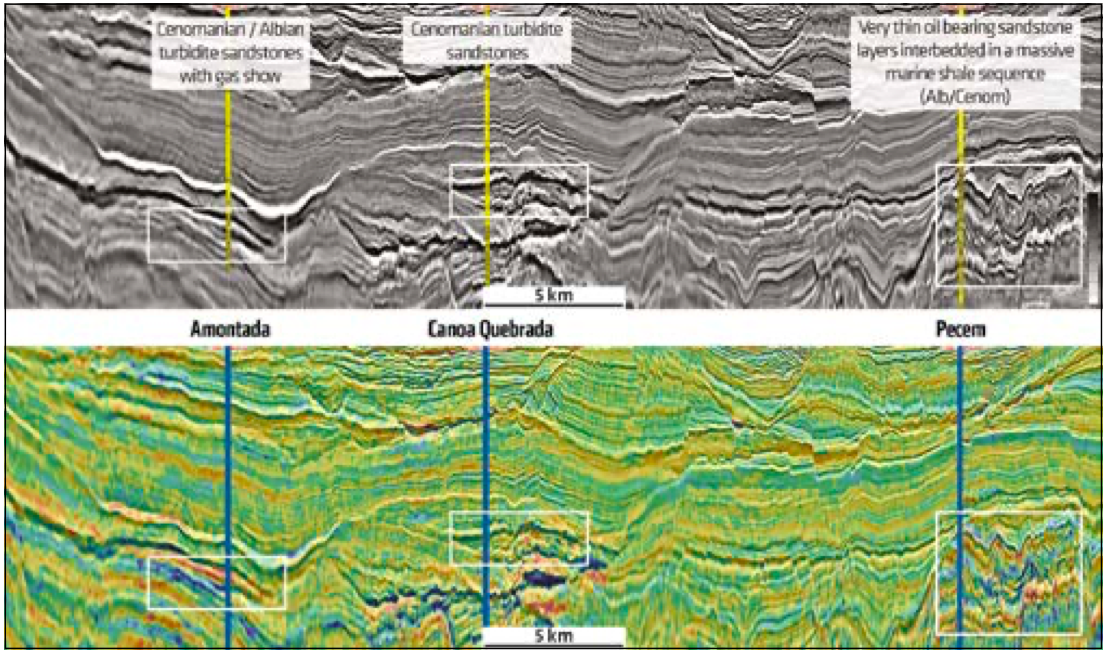
GeoStreamer Data Reveals Exploration Potential
PGS GeoStreamer 3D datasets are positioned to give explorers in Ceará and Potiguar the best opportunity to de-risk these play fairways and prospects.
Significant shallow water discoveries have been made in both the Ceará and Potiguar Basins, while the largest oil-producing region in Equatorial Brazil is the onshore portion of the Potiguar Basin, where production is from the syn-rift to transitional successions. However, only a few deepwater exploration wells have been drilled in the Equatorial Margin from the Amazonas Cone to the Potiguar Basin.

The offshore plays are structural and stratigraphic traps in the Upper Cretaceous reservoir section. Tests of these reservoirs along the conjugate margin in West Africa have precipitated a move by explorers to examine the Equatorial Margin from Brazil to Guyana from a new perspective. Zaedyus in French Guiana was an early geologic success and Liza and associated prospects in Guyana have become the poster child for economic success in these play fairways on the South America Equatorial Margin.
Structural Setting and Significant Wells
The dip seismic line in the foldout (Figure 1) shows rotated fault blocks in the rift section, overlain by Cretaceous syn-rift sediments, which in turn transition to post-rift turbidite onlap facies. There is an interval of additional sedimentation prior to Tertiary erosional events as well as volcanic intrusions. In the strike direction (Figure 2), there is a highly faulted and folded zone associated with the Romanche Fracture Zone to the north-west.

Spectral decomposition is a useful tool for showing geomorphology and depositional system components on high quality seismic data. Figure 3 shows some of the details of a channel system as it meanders down dip to the basin floor. The late Cretaceous reservoir play fairway has been penetrated by the Pitu and Pecem wells.
The Pitu Well, Potiguar Basin
The Pitu well in the Potiguar Basin found oil, gas and condensate at depths of 4,150m to 4,450m in Upper Aptian sands in the Pescada Formation. The discovery well was spudded in 2013 in 1,731m of water, 55 km offshore Brazil’s Rio Grande do Norte and the prospect is still considered to be in appraisal. It reached a total depth of 5,353m and discovered a 188m column of intermediate 24° API gravity oil.
The Pecem Well, Ceará Basin
The Pecem well in the Ceará Basin (Mundau Subbasin), 76 km offshore from the county of Paracuru, spudded in 2012 in a water depth of 2,129m and found a hydrocarbon column estimated to be 290m. The oil-bearing sands are Aptian age in the Paracuru Formation. The oil discovered in this well indicates a transitional environment source but could also include a contribution from the same Albian-Cenomanian source rock system present in the equatorial margin of West Africa. The dip seismic line through the Pecem well location (Figure 1) illustrates the Pecem High and onlapping intervals above it.
Regional deepwater seals
The deepwater seals for both the Ceará and Potiguar Basins are regional shales from the Cretaceous to the Tertiary. Mass-wasting events in the Upper Tertiary could cause seal failure for younger stratigraphic intervals.
Precise reservoir estimates
PGS GeoStreamer 3D data improves attribute computations and reduces risk with more precise reservoir estimates than conventional streamer data. An arbitrary well tie line (Figure 4) shows the Amontada, Canoa Quebrada and Pecem wells. The Albian/Cenomanian section contains turbidite fan/channel systems penetrated by the wells and illustrated on the full stack and Vp/Vs seismic data.

Great Potential Offshore Brazil with Four Source Intervals
The Equatorial Margin of Brazil has four potential sources for exploration prospects and play fairways:
Aptian/Barremian Black Shales
The oldest source system in the Aptian/Barremian is characterized by highly cracked, very mature oils and condensates sourced by a saline to alkaline, calcareous black shale deposited in a lacustrine brackish to saline anoxic environment. This petroleum system sources the majority of current production offshore Brazil.
Late Aptian Source Rocks
The second oil system is characterized by transitional environments, as found in the Ceará and Potiguar Basins, with the Late Aptian source rocks in the early to peak oil window stage. Most of the Equatorial Brazilian continental margin basins have little salt in the transition from continental to marine environments. The Ceará Basin may be the exception, as a few boreholes encountered evaporites in the Late Aptian stratigraphic interval, indicating a restricted depositional environment. Geochemical data from hydrocarbons recovered from oil fields in the Ceará and Potiguar Basins in northern Brazil indicate the presence of oil types similar to the ones that are present in the salt basins south of the equatorial transform fault zones. Consequently, the transform margin basins may share similar source rock systems.
Albian/Cenomanian/Turonian Marine Black Shales
The third petroleum source consists of Albian/Cenomanian/Turonian marine black shales, which are a major source for the oils in the West African salt basins. Similar oils have also been recovered in the Amazonas Cone and Pará-Maranhão Basins and in five ultra-deepwater discoveries in the Sergipe Basin. The origin of the marine hydrocarbons in these systems is related to Late Cretaceous global Oceanic Anoxic Events, which occurred when the two plates were totally separated and the basins were influenced by worldwide sea level rises and falls.
Tertiary Source Rocks
The fourth source system consists of Tertiary source rocks deposited in deltaic environments in the Pará-Maranhão Basin. The 1-PAS-9 and 1-PAS-11 sub-commercial discoveries, as well as the gas accumulations in a number of wells drilled in past decades, were sourced by these Tertiary source systems.
Deepwater Exploration Offshore Brazil Potential Revealed
The current play fairways, demonstrated by recent drilling and seismic stratigraphy combined with seismic attributes from high quality GeoStreamer data, are generally underexplored on the Brazilian Equatorial Margin. Since 2015 PGS has undertaken an extensive series of GeoStreamer 3D surveys to address exploration concerns and de-risk play elements in the Potiguar and Ceará Basins.
Future exploration using these excellent 3D seismic datasets should lead to continued successes for the oil and gas industry in Brazil.




